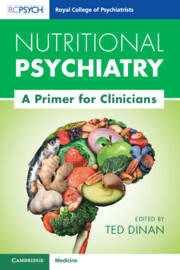Book contents
- Nutritional Psychiatry
- Nutritional Psychiatry
- Copyright page
- Contents
- Contributors
- Preface
- Chapter 1 Basic Principles of Nutrition
- Chapter 2 Diet and the Microbiome–Gut–Brain Axis
- Chapter 3 The Mediterranean Diet and Mental Health
- Chapter 4 Psychobiotics and Fermented Foods
- Chapter 5 Diet Interventions for Anxiety and Depression
- Chapter 6 Schizophrenia, Microbiota and Nutrition
- Chapter 7 Recognising the Importance of Nutrition for Child and Adolescent Mental Health
- Chapter 8 Old Age and Nutrition
- Chapter 9 Broad-Spectrum Micronutrients and Mental Health
- Chapter 10 Epigenetics
- Index
- References
Chapter 9 - Broad-Spectrum Micronutrients and Mental Health
Published online by Cambridge University Press: 17 August 2023
- Nutritional Psychiatry
- Nutritional Psychiatry
- Copyright page
- Contents
- Contributors
- Preface
- Chapter 1 Basic Principles of Nutrition
- Chapter 2 Diet and the Microbiome–Gut–Brain Axis
- Chapter 3 The Mediterranean Diet and Mental Health
- Chapter 4 Psychobiotics and Fermented Foods
- Chapter 5 Diet Interventions for Anxiety and Depression
- Chapter 6 Schizophrenia, Microbiota and Nutrition
- Chapter 7 Recognising the Importance of Nutrition for Child and Adolescent Mental Health
- Chapter 8 Old Age and Nutrition
- Chapter 9 Broad-Spectrum Micronutrients and Mental Health
- Chapter 10 Epigenetics
- Index
- References
Summary
This chapter summarises evidence relating to the importance of nutrient intake from diet and supplementation to brain health. Circumstances that may contribute to an individual requiring additional nutrients beyond what are available in diet, such as consumption of nutritionally depleted food, individual differences in biological need, long-term medication use and gut–brain health needs, are detailed. These factors support the use of a broad spectrum of nutrients to address personal metabolic needs or environmentally induced nutrient depletions. The evidence for treating psychological symptoms with supplementary nutrients is reviewed, summarising research using broad-spectrum micronutrients in the treatment of mental health issues including aggression, autism, attention deficit hyperactivity disorder, anxiety and stress, mood disorders, and psychosis. The breadth and consistency of the findings highlight the importance of receiving a complete foundation of nutrients to optimise brain health. Documented safety and lack of toxicity provide reassurance that this treatment approach does not result in serious or long-term adverse events. The question of pre-treatment nutrient level testing is discussed. Finally, we offer practical suggestions to clinicians interested in incorporating this information into their clinical practice, discussing these suggestions within the context of informed consent.
- Type
- Chapter
- Information
- Nutritional PsychiatryA Primer for Clinicians, pp. 152 - 171Publisher: Cambridge University PressPrint publication year: 2023
References
- 1
- Cited by

